Related Research Articles
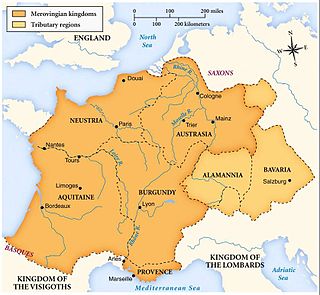
The Merovingian dynasty was the ruling family of the Franks from the middle of the 5th century until 751. They first appear as "Kings of the Franks" in the Roman army of northern Gaul. By 509 they had united all the Franks and northern Gaulish Romans under their rule. They conquered most of Gaul, defeating the Visigoths (507) and the Burgundians (534), and also extended their rule into Raetia (537). In Germania, the Alemanni, Bavarii and Saxons accepted their lordship. The Merovingian realm was the largest and most powerful of the states of western Europe following the breaking up of the empire of Theodoric the Great.

Gregory of Tours was a Gallo-Roman historian and Bishop of Tours, making him a leading prelate of the area that had been previously referred to as Gaul by the Romans. He was born Georgius Florentius and later added the name Gregorius in honor of his maternal great-grandfather. He is the primary contemporary source for Merovingian history. His most notable work was his Decem Libri Historiarum, better known as the Historia Francorum, a title that later chroniclers gave to it. He is also known for his accounts of the miracles of saints, in particular four books of the miracles of Martin of Tours. St. Martin's tomb was a major pilgrimage destination in the 6th century, and St. Gregory's writings had the practical effect of promoting highly organized devotion.
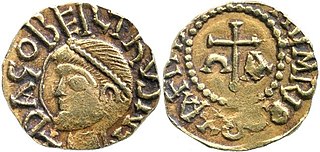
Dagobert I was the king of Austrasia (623–634), king of all the Franks (629–634), and king of Neustria and Burgundy (629–639). He has been described as the last king of the Merovingian dynasty to wield any real royal power. Dagobert was the first of the Frankish kings to be buried in the royal tombs at Saint Denis Basilica.

Francia, also called the Kingdom of the Franks, Frankish Kingdom, Frankland or Frankish Empire, was the largest post-Roman barbarian kingdom in Western Europe. It was ruled by the Franks during late antiquity and the Early Middle Ages. After the Treaty of Verdun in 843, West Francia became the predecessor of France, and East Francia became that of Germany. Francia was among the last surviving Germanic kingdoms from the Migration Period era before its partition in 843.

Venantius Honorius Clementianus Fortunatus, known as Saint Venantius Fortunatus, was a Latin poet and hymnographer in the Merovingian Court, and a bishop of the Early Church who has been venerated since the Middle Ages.
In the Western Church of the Early and High Middle Ages, a sacramentary was a book used for liturgical services and the mass by a bishop or priest. Sacramentaries include only the words spoken or sung by him, unlike the missals of later centuries that include all the texts of the mass whether read by the bishop, priest, or others. Also, sacramentaries, unlike missals, include texts for services other than the mass such as ordinations, the consecration of a church or altar, exorcisms, and blessings, all of which were later included in Pontificals and Rituals instead.
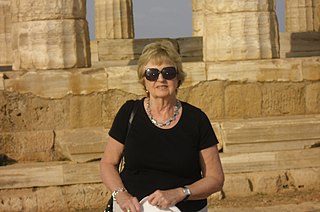
Dame Averil Millicent Cameron, often cited as A. M. Cameron, is a British historian. She was Professor of Late Antique and Byzantine History at the University of Oxford, and the Warden of Keble College, Oxford, between 1994 and 2010.
A pontifical is a Christian liturgical book containing the liturgies that only a bishop may perform. Among the liturgies are those of the ordinal for the ordination and consecration of deacons, priests, and bishops to Holy Orders. While the Roman Pontifical and closely related Ceremonial of Bishops of the Roman Rite are the most common, pontificals exist in other liturgical traditions.
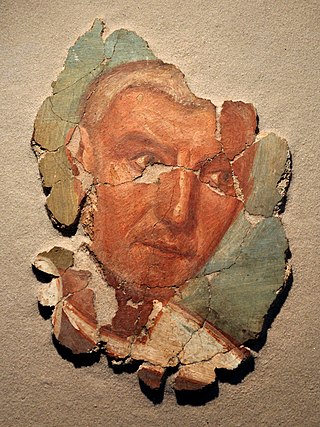
Gallo-Roman culture was a consequence of the Romanization of Gauls under the rule of the Roman Empire. It was characterized by the Gaulish adoption or adaptation of Roman culture, language, morals and way of life in a uniquely-Gaulish context. The well-studied meld of cultures in Gaul gives historians a model against which to compare and contrast parallel developments of Romanization in other less-studied Roman provinces.
Yitzhak Hen is Anna and Sam Lopin Professor of History, formerly at Ben-Gurion University of the Negev (Israel). Since August 2018 he has been the director of Israel Institute for Advanced Studies at the Hebrew University of Jerusalem.
Erminethrudis, was a nun and a member of the Merovingian aristocracy who died in Paris about 600, leaving a will which survived as a rare example from the period.
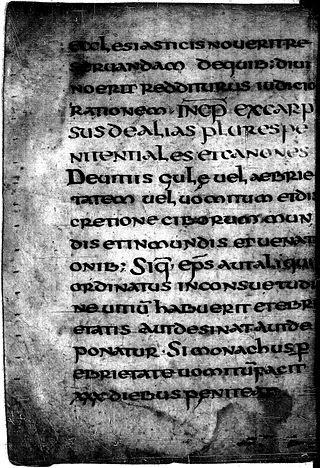
The Excarpsus Cummeani, also called the Pseudo-Cummeani, is an eighth-century penitential, probably written in the north of the Frankish Empire in Corbie Abbey. Twenty-six copies of the manuscript survive; six of those were copied before 800 CE. It is possible that the penitential, which extends its scope beyond monasticism to include clerics and lay people, has a connection to Saint Boniface and his efforts to reform the Frankish church in the first half of the eighth century. Geographic spread by the end of the eighth century and continued copying of the manuscript into the 9th and 10th centuries have been interpreted to mean the work was considered "by the Christian authorities" a canonical text. It was used as late as the eleventh century, "as the main source of the P. Parisiense compositum".
The Bobbio Missal is a seventh-century Christian liturgical codex that probably originated in France.

Moutiers-Saint-Jean Abbey was a monastery located in what is now the village of Moutiers-Saint-Jean in the Côte-d'Or department in eastern France. It is in Burgundy, near Dijon.
Guy Halsall is an English historian and academic, specialising in Early Medieval Europe. He is currently based at the University of York, and has published a number of books, essays, and articles on the subject of early medieval history and archaeology. Halsall's current research focuses on western Europe in the important period of change around AD 600 and on the application of continental philosophy to history. He taught at the University of Newcastle and Birkbeck, University of London, before moving to the University of York.
Julia Mary Howard Smith, is Chichele Professor of Medieval History at All Souls College, Oxford. She was formerly Edwards Professor of Medieval History at the University of Glasgow. She is a graduate of Newnham College, University of Cambridge, and Corpus Christi College, University of Oxford.
Janneke Ellen Raaijmakers was a Dutch historian of the Middle Ages who specialized in the formation of monastic communities and the role of religious objects in the cult of the saints, with a particular focus on Fulda and the Fulda monastery, founded by Saint Boniface.
Agrestius was a Burgundian Frankish nobleman and monk.

Mayke de Jong is a Dutch historian and Professor Emerita of Medieval History at Utrecht University. Her research focuses on the political and religious history of the early Middle Ages.
Katherine L. Jansen is an American historian and professor of medieval history at The Catholic University of America in Washington, D.C. She also has served as Visiting Professor at the Johns Hopkins University and Princeton University.
References
- ↑ Rob Meens CV
- ↑ "Davis Center, Princeton University, Past Fellows". Princeton University . Retrieved 22 August 2014.
- ↑ "Rob Meens". Bonifatii et Lulli Epistolae Project. Archived from the original on 22 August 2014. Retrieved 22 August 2014.
- ↑ Noble, Thomas F. X. (2006). "Rev. of Hen, Meens, "The Bobbio Missal": Liturgy and Religious Culture in Merovingian Gaul". Church History . 7 (2): 414–15. JSTOR 27644774.
- ↑ Paxton, Frederick S. (2006). "Rev. of Hen, Meens, "The Bobbio Missal": Liturgy and Religious Culture in Merovingian Gaul". The Journal of English and Germanic Philology . 105 (2): 345–47. JSTOR 27712591.
- ↑ Moreira, Isabel (2006). "Rev. of Hen, Meens, "The Bobbio Missal": Liturgy and Religious Culture in Merovingian Gaul". Speculum . 81 (3): 860–61. doi:10.1017/s0038713400016110. JSTOR 20463870.
- ↑ Larson, Atria A. (2014). Master of Penance. CUA. p. 7. ISBN 9780813221687.
- ↑ Didde, René (31 August 2002). "De Middeleeuwen van het volk". de Volkskrant (in Dutch). Retrieved 4 August 2014.
- ↑ "Penance Medieval Europe 600-1200". Cambridge UP. Retrieved 4 August 2014.